When spotting fox or dog tracks, notice the shape, spacing, and patterns closely. Fox prints are narrow with a diamond shape, while dog tracks are wider and rounded. Foxes space their pads farther apart, making their claws long and thin, unlike dogs with shorter, thick claws. Look for a direct path in fox tracks, versus the random wandering of dogs. Seeing a diagonal trot with hind and front feet separated helps identify a fox. Remember, understanding track details is key. Keep exploring for fascinating insights into distinguishing between these clever canines.
Key Takeaways
- Fox tracks are narrow and diamond-shaped, while dog tracks are wider and rounded.
- Fox pads are smaller and farther apart, while dog pads are closer and more aligned.
- Foxes trot diagonally with hind feet on one side, distinct from dog tracks.
- Fox claws are thin and long with pointed marks, unlike dog claws.
- Examining track patterns and gait differences helps differentiate between fox and dog tracks.
Key Differences in Track Patterns
When observing track patterns, one can easily distinguish between fox and dog prints by noting specific differences.
Fox tracks have elongated prints with a large gap between pads, which sets them apart from dog tracks. Foxes exhibit purposeful and linear patterns in their tracks, unlike dogs that may display more random patterns. Additionally, foxes often have a small straddle with their feet closer to the median line in their tracks, a characteristic not commonly seen in dogs.
Another key difference is that foxes tend to direct register, meaning they place their rear feet where their front feet were, a behavior less frequently observed in dogs. Moreover, foxes trot diagonally, positioning their hind feet on one side and their front feet on the other, which is a distinctive feature that helps differentiate their track patterns from those of dogs.
Fox Vs. Dog Track Shape
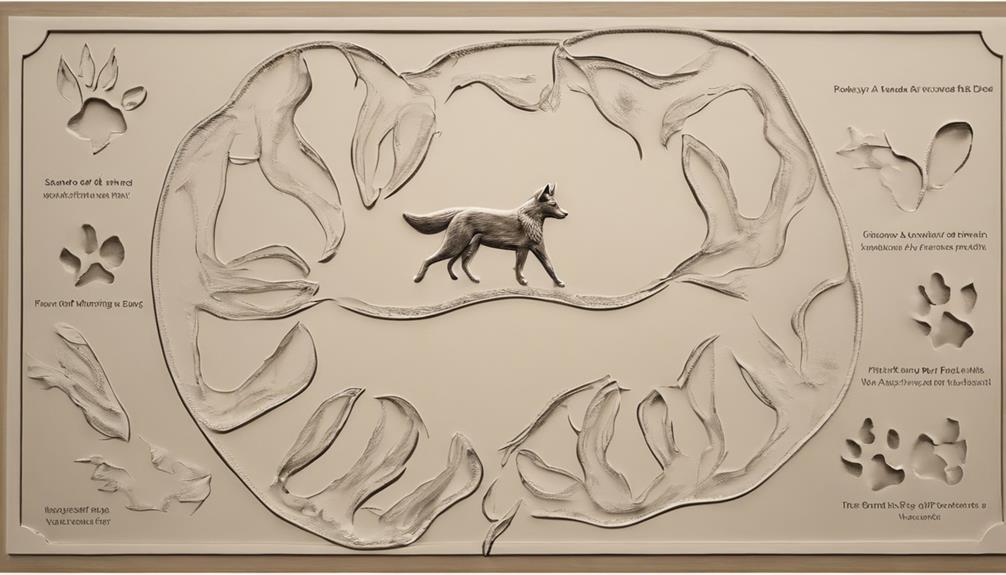
When distinguishing between fox and dog tracks, it's crucial to pay close attention to the shape of the prints.
Fox tracks tend to be narrower and diamond-shaped, while dog tracks are wider and more rounded.
Track Shape Comparison
Comparing the track shapes of foxes and dogs reveals distinct differences in print size, pad arrangement, and claw characteristics. Here is a comparison table showcasing these variations:
| Aspect | Fox | Dog |
|---|---|---|
| Print Shape | Narrow, diamond-shaped prints | Wider, more rounded prints |
| Pad Size | Smaller and farther apart | Larger and closer together |
| Claw Characteristics | Thin and long claws | Short and thick claws |
Understanding these unique features can help differentiate between fox and dog tracks in the wild. Fox tracks often exhibit a purposeful, linear pattern, while dog tracks may appear more random. By observing these distinctions, one can gain valuable insights into the animals' movements and behaviors.
Paw Print Analysis
In analyzing paw prints, one can easily distinguish between fox and dog tracks based on their distinctive shapes and sizes. Fox paw prints are narrower and diamond-shaped, while dog prints are wider and more rounded. Fox pads are smaller and spaced farther apart, with fox claws being thinner and longer than those of dogs.
Additionally, foxes exhibit a more purposeful and linear track pattern compared to dogs, reflecting their wild instincts. Understanding these differences can help in identifying whether the tracks belong to a dog or a wild fox.
Species Identification Differences
By observing the shape and spacing of tracks, we can easily distinguish between fox and dog prints in the wild.
- Fox tracks typically look like foxes with narrower, diamond-shaped prints, while dog tracks appear wider and more rounded.
- The spacing between pads in fox tracks is generally smaller and farther apart compared to dog tracks, aiding in differentiation.
- Examining the spacing between pads is vital as the closer and more aligned pads are in fox tracks, the more likely they're to belong to a fox rather than a dog.
Examining Paw Print Spacing

When examining paw print spacing, it's important to pay attention to the alignment of the prints and the length of the tracking stride.
Paw print alignment refers to how the prints are positioned in relation to each other, indicating the animal's gait.
Tracking stride length can show how far apart the prints are from one another, helping determine if they belong to a fox or a dog.
Understanding these key points can assist in accurately identifying the animal behind the tracks.
Paw Print Alignment
Examining paw print spacing reveals distinct differences between foxes and dogs, with fox prints often displaying a direct register and closer alignment compared to the wider gap seen in dog prints.
When analyzing paw print alignment, it's important to note the following:
- Fox paw prints show a direct register, where the rear feet align with the front feet, creating a more linear track pattern.
- Dog paw prints, on the other hand, typically exhibit a wider gap between the front and rear feet, resulting in a less aligned and more staggered appearance.
- The spacing and alignment of paw prints serve as vital indicators for distinguishing between foxes and dogs, providing valuable insights into tracking and identifying these animals based on their unique print characteristics.
Tracking Stride Length
After observing the distinct differences in paw print alignment between foxes and dogs, the focus now shifts to analyzing the tracking stride length, particularly in relation to paw print spacing.
Foxes typically have a smaller stride length between paw prints, showcasing a more precise and deliberate spacing in their tracks. On the other hand, dogs may exhibit a wider stride length with paw prints placed farther apart.
Fur Presence Between Pads
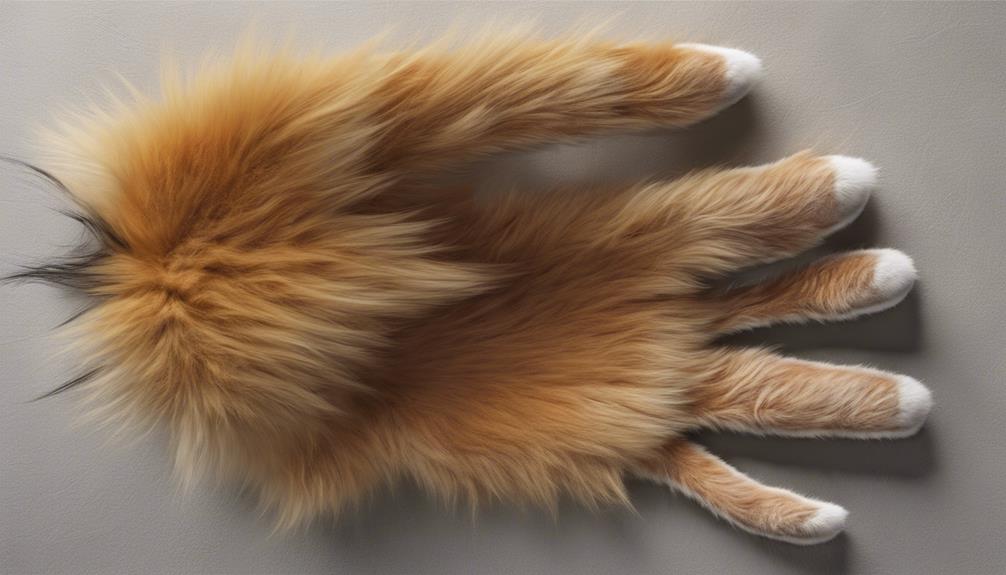
In fox tracks, the dense fur found between the pads serves as a distinguishing feature, particularly noticeable during winter months. This fur presence between the pads is a key characteristic that helps differentiate fox tracks from those of dogs.
- Insulation and Protection: The fur between the pads in fox tracks isn't just for show. It actually provides insulation and protection for the fox's paws, allowing them to navigate through various terrains and weather conditions comfortably.
- Distinct Appearance: Observing the fur between the pads can reveal the distinct appearance of fox tracks compared to those of dogs. This unique feature is a clue that can lead you to correctly identify the animal that left the tracks.
- Identification Marker: When tracking animals, paying attention to the fur presence between the pads is vital. It acts as a reliable identification marker, guiding you towards recognizing whether the tracks belong to a fox or a dog.
Clues From Claw Length
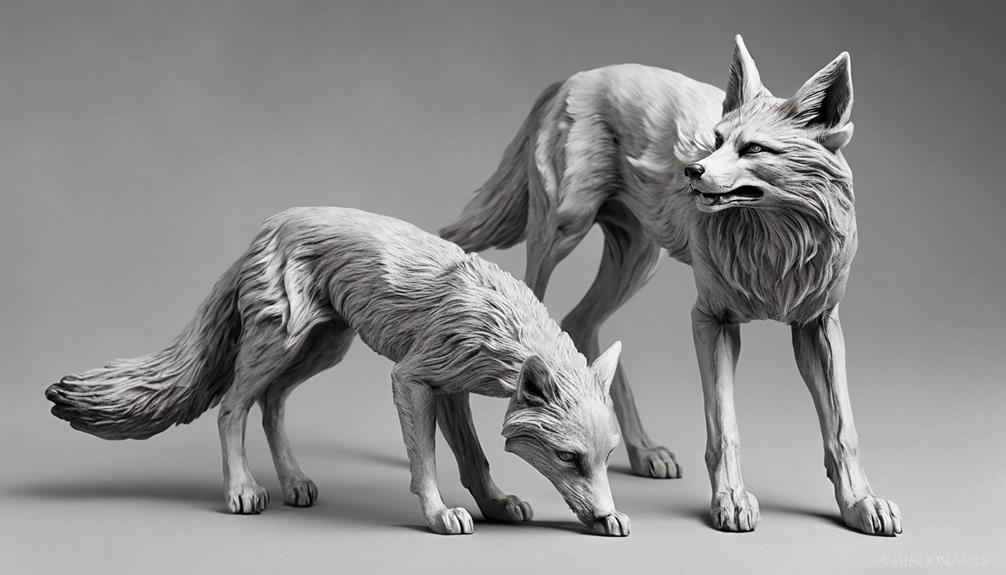
We can easily distinguish between fox and dog tracks by examining the claw length, as fox claws are typically longer and sharper compared to dog claws. When tracking, look for tracks with longer, more pointed claw marks, as this is a clear indication of a fox print.
Foxes, such as the red fox and Arctic fox, rely on their sharp claws for various activities like hunting and climbing. These activities result in distinct claw marks that stand out in their tracks. On the other hand, dogs have shorter and thicker claws, which leave different imprints compared to foxes.
Analyzing Print Size and Shape
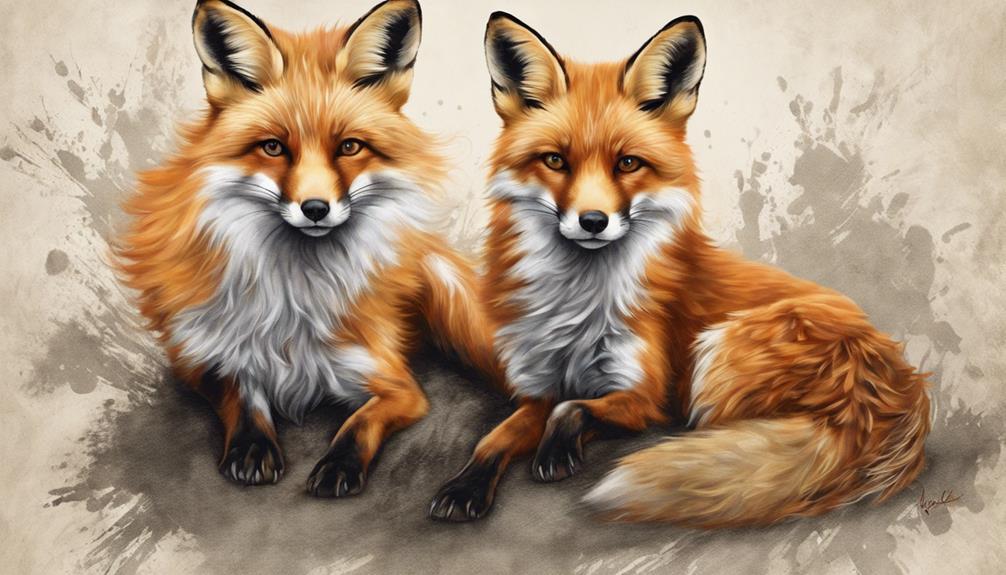
Examining the size and shape of prints can provide essential insights into distinguishing between fox and dog tracks.
- Fox prints typically have a narrower, diamond-shaped appearance, while dog prints are wider and more rounded in shape. These distinctions in shape can be pivotal in differentiating between the two animals at a glance.
- Another key difference lies in the paw pads of foxes and dogs. Fox paw pads are generally smaller and placed farther apart, whereas dog paw pads tend to be larger and closer together. Observing these differences can help in accurately identifying the animal responsible for the tracks.
- Additionally, the claws in the prints can also offer clues. Dog claws are often shorter and thicker, while fox claws are more slender. Paying attention to the claw marks left behind in the tracks can aid in determining whether the prints belong to a fox or a dog.
Understanding these nuances in print size, shape, and paw pads is essential in distinguishing between fox and dog tracks accurately.
Gait Variations in Canines
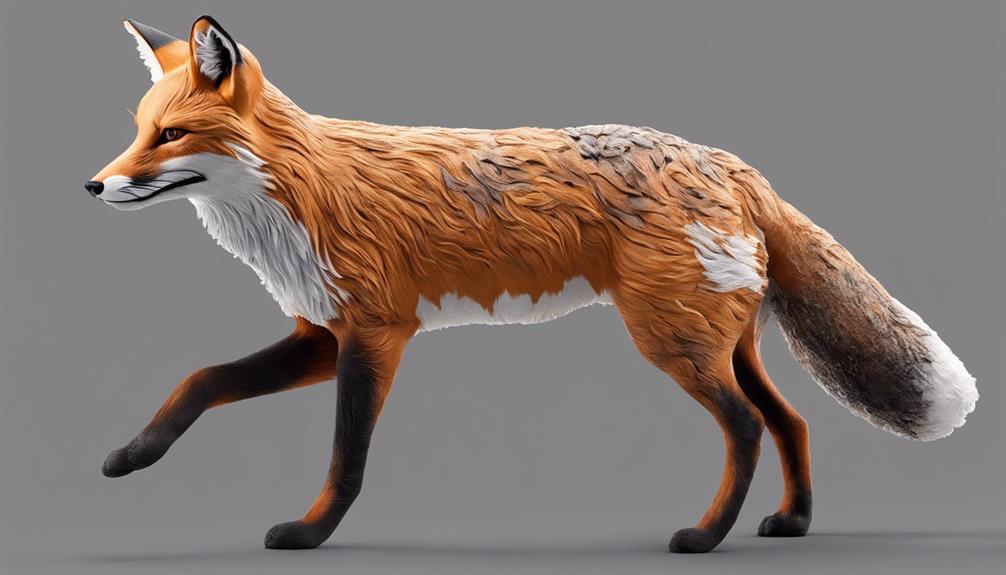
Exploring the distinctive gait variations in canines reveals fascinating insights into their movement patterns and behaviors. Fox species, known for their slender build, exhibit a small straddle, with their feet positioned closer to the median line. When tracking, foxes often engage in direct registering, where their rear feet fall precisely where their front feet were placed. Additionally, foxes trot diagonally, creating a unique track pattern with hind feet on one side and front feet on the other.
Interestingly, domestic dogs may also display similar traits in their track patterns, occasionally trotting at an angle akin to foxes. However, a key differentiator lies in the shape of their prints. Fox prints typically feature a narrower, diamond shape, while dog prints tend to be wider and more rounded. By observing these gait variations and track patterns, one can gain valuable insights into the movements of canines, whether they're foxes or domestic dogs.
Identifying Linear Vs. Random Tracks

In comparing the purposeful and linear tracks of foxes to the more random tracks of dogs, a distinct difference emerges in their movement patterns.
- Fox tracks exhibit a deliberate and intentional path, often showing a straight line with a clear direction, reflecting the fox's focused and strategic movement.
- Dog tracks, on the other hand, tend to meander and wander, displaying a more random and less structured pattern, indicating the dog's exploratory and curious nature.
- The diagonal gait seen in fox tracks, where the hind feet fall on one side and the front feet on the other, is a key distinguishing feature from the more varied gait patterns found in dog tracks.
Understanding these differences can help us decipher the tracks left behind by these animals, providing insights into their behaviors and movements. Following this, we'll explore further into deciphering fox and dog tracks to enhance our understanding.
Deciphering Fox and Dog Tracks

Decoding the distinct characteristics of fox and dog tracks offers valuable insights into their movements and behaviors. Fox tracks typically have elongated prints with a large gap between pads, while dog tracks appear wider and more rounded, with shorter, thicker claws.
To differentiate between the two, examining the track patterns is essential. Foxes often display purposeful and linear track patterns, with dense fur between pads, especially noticeable in winter. They tend to have a small straddle and may direct register, a behavior where they place their rear feet where their front feet were.
When observing tracks in the wild, noticing how foxes trot diagonally with hind feet on one side and front feet on the other can help distinguish them from dogs. Additionally, placing blades of grass in an X shape between pads can aid in identifying fox tracks, as this species tends to move in a more streamlined and deliberate manner compared to dogs.
Frequently Asked Questions
Who Would Win a Fox or a Dog?
When considering a hypothetical confrontation, it's important to weigh factors like size, strength, and behavior.
In a matchup between a fox and a dog, the outcome may depend on these characteristics. Dogs, being larger and domesticated animals with a history of working alongside humans, could potentially have an advantage over foxes.
However, foxes are known for their agility and cunning, which could play a role in determining the winner of such a confrontation.
How Can You Tell the Difference Between a Fox and a Dog?
When differentiating between a fox and a dog, observe the track details closely. Fox tracks are narrow and diamond-shaped, with smaller, widely spaced pads and sharp claws.
Dogs leave wider, rounder prints with larger, closer pads and shorter, thicker claws. Foxes tend to show a purposeful, linear track pattern, occasionally directing register.
Paying attention to these distinctions will help you identify whether you're tracking a fox or a dog accurately.
Are Foxes Friendly With Dogs?
Foxes and dogs can develop friendships based on individual traits and socialization. Careful introductions and close monitoring are essential for their safety. While curiosity may spark between the two, caution is crucial to avoid conflicts. Proper supervision and training can foster peaceful coexistence in certain scenarios.
Is a Fox Basically a Dog?
A fox isn't basically a dog. While both belong to the same family, Canidae, they've distinct differences in genetics, behaviors, and adaptations.
Foxes are wild animals with unique survival skills, while dogs have been domesticated for thousands of years. Even though they share some physical traits, such as fur color, their chromosome numbers, habitats, and lifestyles set them apart.
Foxes and dogs are separate species with their own evolutionary histories and characteristics.
Conclusion
To sum up, when trying to differentiate between fox and dog tracks, it's important to carefully observe key differences in track patterns, paw print spacing, fur presence between pads, claw length, print size and shape, gait variations, and track linearity.
By analyzing these details closely, one can confidently determine whether the tracks belong to a fox or a dog. Remember, attention to detail is key in identifying these subtle differences in animal tracks.










